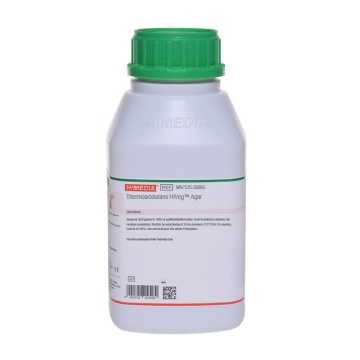 Your enquiry has been submitted
Your enquiry has been submitted
Thermoacidurans Agar
Intended Use
Recommended for isolation of Bacillus thermoacidurans from food products.
Composition**
| Ingredients | Gms / Litre |
|---|---|
| Proteose peptone | 5.000 |
| Yeast extract | 5.000 |
| Dextrose (Glucose) | 5.000 |
| Dipotassium hydrogen phosphate | 4.000 |
| Agar | 20.000 |
| Final pH (at 25°C) | 5.0±0.2 |
**Formula adjusted, standardized to suit performance parameters
Directions
Suspend 39 grams in 1000 ml purified / distilled water. Heat to boiling to dissolve the medium completely. Sterilize by autoclaving at 15 lbs pressure (121°C) for 15 minutes. Cool to 45-50°C and pour into sterile Petri plates.
Principle And Interpretation
Bacillus coagulans is commonly found in soil and has been isolated from canned tomato products and dairy products. This organism is responsible for flat-sour spoilage of canned foods (4). B. coagulans is also referred to as B. thermoacidurans (1). They are of primary importance in spoilage of low-acid foods packed in hermetically sealed containers (1). Spoilage due to bacterial growth is accompanied by a reduction in pH from 0.3 to 0.5 (5) and also the ends of the can remain flat. Thermoacidurans Agar, described by Stern et al (5) is recommended by APHA (4) for cultivation and isolation of B. coagulans from canned foods. B. coagulans is described as a facultative thermophile, that can grow at 20 to 55°C, and can also grow at pH levels between 5.0 to 7.0. B. stereothermophilus can also grow at 55°C but it can not tolerate a pH value of 5.0 and therefore will now grow on Thermoacidurans Agar.
Proteose peptone and yeast extract provide nitrogenous compounds, vitamin B complex and other essential growth nutrients. Dipotassium hydrogen phosphate buffers the medium. Dextrose acts as an energy source.
Extract juice from the canned foods and subject it to heat shock. Transfer 1 ml of the heat shocked sample to 4 sterile Petri plates and to each of 2 plates, add 10-20 ml Dextrose Tryptone Agar (M092) and to the other 2 plates, add 10-20 ml Thermoacidurans Agar. B. coagulans will form large, cream to white colonies.
Type of specimen
Food samples
Specimen Collection and Handling
For food samples, follow appropriate techniques for sample collection and processing as per guidelines (4).
After use, contaminated materials must be sterilized by autoclaving before discarding.
Warning and Precautions :
Read the label before opening the container. Wear protective gloves/protective clothing/eye protection/ face protection. Follow good microbiological lab practices while handling specimens and culture. Standard precautions as per established guidelines should be followed while handling specimens. Safety guidelines may be referred in individual safety data sheets.
Limitations :
- This medium is general purpose medium and may not support the growth of fastidious organisms.
Performance and Evaluation
Performance of the medium is expected when used as per the direction on the label within the expiry period when stored at recommended temperature.
Quality Control
Appearance Cream to yellow homogeneous free flowing powder
Gelling Firm, comparable with 2.0% Agar gel.
Colour and Clarity of prepared medium Yellow coloured clear to slightly opalescent gel forms in Petri plates
Reaction Reaction of 3.9% w/v aqueous solution at 25°C. pH : 5.0±0.2
pH 4.80-5.20
Cultural Response Cultural characteristics observed after an incubation at 55°C for 18-48 hours.
| Organism | Inoculum (CFU) | Growth | Recovery | Sporulation |
|---|---|---|---|---|
| Bacillus thermoacidurans ATCC 8038 | 50-100 | luxuriant | >=70% | positive |
Key: *Corresponding WDCM numbers.
Storage and Shelf Life
Store between 10-30°C in a tightly closed container and the prepared medium at 20-30°C. Use before expiry date on the label. On opening, product should be properly stored dry, after tightly capping the bottle in order to prevent lump formation due to the hygroscopic nature of the product. Improper storage of the product may lead to lump formation. Store in dry ventilated area protected from extremes of temperature and sources of ignition. Seal the container tightly after use. Use before expiry date on the label.
Product performance is best if used within stated expiry period.
Disposal
User must ensure safe disposal by autoclaving and/or incineration of used or unusable preparations of this product. Follow established laboratory procedures in disposing of infectious materials and material that comes into contact with sample must be decontaminated and disposed of in accordance with current laboratory techniques (2,3).
Reference
- Becker M. E., Pederson C. S., 1950, J. Bacteriol., 459:717
- Isenberg, H.D. Clinical Microbiology Procedures Handbook 2nd Edition.
- Jorgensen, J.H., Pfaller, M.A., Carroll, K.C., Funke, G., Landry, M.L., Richter, S.S and Warnock., D.W. (2015) Manual of Clinical Microbiology, 11th Edition. Vol. 1.
- Salfinger Y., and Tortorello M.L. Fifth (Ed.), 2015, Compendium of Methods for the Microbiological Examination of Foods, 5th Ed., American Public Health Association, Washington, D.C.
- Stern R. N., Hegarty C. P. and Williams O. B., 1942, Food Research, 7:186.
| Product Name | Thermoacidurans Agar |
|---|---|
| SKU | M125 |
| Product Type | Regular |
| Physical Form | Powder |
| Origin | Animal |
| Packaging type | HDPE |
| References | 1. Downes F. P. and Ito K., (Eds.), 2001, Compendium of Methods for the Microbiological Examination of Foods, 4th Ed.,APHA, Washington, D.C. 2.Becker M. E., Pederson C. S., 1950, J. Bacteriol., 459:717 3.Stern R. N., Hegarty C. P. and Williams O. B., 1942, Food Research, 7:186. |
| Customized Product Available | No |





